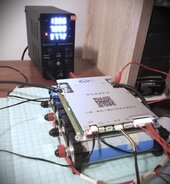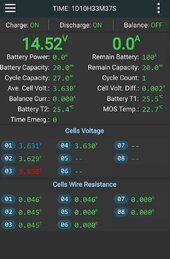I have an older 12V 206Ah SOK in my RV that I just upgraded with SOK's latest bluetooth BMS. I am seeing individual cell voltages for the first time. When charging, one of the cells becomes a runner and trips BMS overcharge early (14.0V; cell diff 0.175V). That also shuts down the RV's inverter-charger early. Most of the articles I found here refer to balancing cells in series, out of the box, with a bench-top power supply. I would like to do it without removing the battery and taking it apart again. Can it be done in-place with a bench-top power supply? If so, can you point me to instructions? I did find an old reference to a top balancing guide but could not find it.
You are using an out of date browser. It may not display this or other websites correctly.
You should upgrade or use an alternative browser.
You should upgrade or use an alternative browser.
balancing an existing battery with a bench-top power supply
- Thread starter SteveSS
- Start date
OffGridForGood
Catch, make or grow everything you can.
12v 4sI would like to do it without removing the battery and taking it apart again. Can it be done in-place with a bench-top power supply? If so, can you point me to instructions?
If you can leave the cells in place and remove the cover to have access to the bus bars, you can manually balance them here is what I have done:
charge up the pack until you hit high voltage disconnect. Remove the pack cover so you have access to the cells.
From the BMS data you will know which cell is the runner - say it is cell #2 for example.
Connect an automotive bulb (headlight or other high amperage bulb works well for this) connect the automotive bulb to the neg and pos of cell #2 - all the other bus bars and BMS leads remain untouched. The light bulb will glow at a low intensity due to the low 3.6 volts, but it will pull down Cell #2. Watch the BMS as you do this, and see when Cell #2 comes into the same voltage as cells 1,3,& 4. When it does, disconnect the automotive bulb.
But keep watching, most often the cell voltage will 'rebound' higher as soon as you remove the load. You may find, as I did, that to get that cell to match the other cells, you need to pull it's voltage a few milli-volts lower than the others, then when you remove the bulb it will rebound but end at the voltage you wanted.
Now you can charge the pack up a bit higher - maybe your target fully charge voltage is 14 volts (3.50 per cell) if the cells are lower due to the runner cutting off the charge early, now that you have pulled Cell #2 down close to the others, you can return to charging the pack again, it may be necessary to put the automotive bulb back on Cell #2 again as you charge, to keep that cell from running off again. The goal is to have all the cells in balance as the pack reaches the target fully charged voltage.
Pi Curio
Sunlicious
Does your BMS have an active balancer?
If it does, here's how I've top-balanced the cells in a small 12V 20Ah LiFePO4 battery;
Charged the battery up to 14V with CC(constant current) of 7A, but you can do 13.8V if necessary just takes more time in CV part.

When the first cell hit approximately 3.5V I proceeded with the CV(Constant voltage) with a reduced roughly 0.5A constant just to keep the cells at proper constant voltage while at the same time, I enabled the active balancing of 1.5A down to 0.003mV Delta and left it for 25min ish.
Then the last 10 minutes at a reduced balancing of 0.3A.(approx estimate of correct balancing current for a 20Ah capacity) The result was 0.002mV Delta between the cells, and the battery was ready to use.
Important, I had a BMS hooked up with proper settings to protect the battery in any event before doing this.
Funny enough, I did the top balancing manually at first with the power supply, but the results were not nearly as good as doing it with the BMS.
Hope it helps get some reference.
LE: Just did a test run charging up to 14.52V and kept it there for 20 minutes.

If it does, here's how I've top-balanced the cells in a small 12V 20Ah LiFePO4 battery;
Charged the battery up to 14V with CC(constant current) of 7A, but you can do 13.8V if necessary just takes more time in CV part.

When the first cell hit approximately 3.5V I proceeded with the CV(Constant voltage) with a reduced roughly 0.5A constant just to keep the cells at proper constant voltage while at the same time, I enabled the active balancing of 1.5A down to 0.003mV Delta and left it for 25min ish.
Then the last 10 minutes at a reduced balancing of 0.3A.(approx estimate of correct balancing current for a 20Ah capacity) The result was 0.002mV Delta between the cells, and the battery was ready to use.
Important, I had a BMS hooked up with proper settings to protect the battery in any event before doing this.
Funny enough, I did the top balancing manually at first with the power supply, but the results were not nearly as good as doing it with the BMS.
Hope it helps get some reference.
LE: Just did a test run charging up to 14.52V and kept it there for 20 minutes.

Last edited:
My current project I’m working on is a 280Ah 8s build. I let the BMS handle the cells up to hvd. On mine #8 was the runner at 3.6V, BMS stopped charging the pack.
3 cells were much lower than the rest, so I got out my bench power supply, and started charging the lowest cells. So far I have most cells at 3.33+ and the 4 lower cells I charge up to 3.45 then move to the next cell.
As soon as all cells have hit 3.45V I will reconnect full bank charging and track if any run high.
3 cells were much lower than the rest, so I got out my bench power supply, and started charging the lowest cells. So far I have most cells at 3.33+ and the 4 lower cells I charge up to 3.45 then move to the next cell.
As soon as all cells have hit 3.45V I will reconnect full bank charging and track if any run high.
Thanks, but my BMS only has passive balancing. It looks like I will be removing the battery and taking the lid off after all.Does your BMS have an active balancer?
If it does, here's how I've top-balanced the cells in a small 12V 20Ah LiFePO4 battery;
Charged the battery up to 14V with CC(constant current) of 7A, but you can do 13.8V if necessary just takes more time in CV part.
View attachment 204143
When the first cell hit approximately 3.5V I proceeded with the CV(Constant voltage) with a reduced roughly 0.5A constant just to keep the cells at proper constant voltage while at the same time, I enabled the active balancing of 1.5A down to 0.003mV Delta and left it for 25min ish.
Then the last 10 minutes at a reduced balancing of 0.3A.(approx estimate of correct balancing current for a 20Ah capacity) The result was 0.002mV Delta between the cells, and the battery was ready to use.
Important, I had a BMS hooked up with proper settings to protect the battery in any event before doing this.
Funny enough, I did the top balancing manually at first with the power supply, but the results were not nearly as good as doing it with the BMS.
Hope it helps get some reference.
LE: Just did a test run charging up to 14.52V and kept it there for 20 minutes.
View attachment 204179
OffGridForGood
Catch, make or grow everything you can.
I think you will be fine once you get the initial balance worked out.Thanks, but my BMS only has passive balancing. It looks like I will be removing the battery and taking the lid off after all.
I find my BMS's with passive balance work well once the initial top balance is done, as long as the pack sees regular charge/discharge and reaches full charge at least once per week.
Of the two options suggested, discharge the one runner or charge the three laggers, I am leaning toward yours since I don't have a spare headlight bulb handy. Before proceeding, do I need to isolate them all, i.e., disconnect bus bars, BMS wires, etc?My current project I’m working on is a 280Ah 8s build. I let the BMS handle the cells up to hvd. On mine #8 was the runner at 3.6V, BMS stopped charging the pack.
3 cells were much lower than the rest, so I got out my bench power supply, and started charging the lowest cells. So far I have most cells at 3.33+ and the 4 lower cells I charge up to 3.45 then move to the next cell.
As soon as all cells have hit 3.45V I will reconnect full bank charging and track if any run high.
OffGridForGood
Catch, make or grow everything you can.
Either way will work, and no you don't need to isolate them from each other.Of the two options suggested, discharge the one runner or charge the three laggers, I am leaning toward yours since I don't have a spare headlight bulb handy. Before proceeding, do I need to isolate them all, i.e., disconnect bus bars, BMS wires, etc?
If the ones you want to charge are all together - 1,2,3 cells, you can put your bench source to a suitable voltage x 3 and connect from the most neg to the most pos of just those three cells, you don't have to do the cells one at a time.
RCinFLA
Solar Wizard
- Joined
- Jun 21, 2020
- Messages
- 3,565
The internal BMS battery balancer is likely resistive dump with about 100 mA of bleed current. It can take a long time held at 14.0v to balance out cells.
Anything greater than about 1% difference in cells SoC can cause overvoltage cell charging shutdown when attempting a full charge. 1% of 206 AH is 2.06 AH. At 100mA balancing dump that will take 20.6 hours to balance out. The more out of balance, the longer it takes.
When cells are out of balance, the greater the charge bulk current, the more likely it is one cell will overvoltage quickly.
A cell must be above 3.4v for balancing bleed to occur.
Anything greater than about 1% difference in cells SoC can cause overvoltage cell charging shutdown when attempting a full charge. 1% of 206 AH is 2.06 AH. At 100mA balancing dump that will take 20.6 hours to balance out. The more out of balance, the longer it takes.
When cells are out of balance, the greater the charge bulk current, the more likely it is one cell will overvoltage quickly.
A cell must be above 3.4v for balancing bleed to occur.
Last edited:
Similar threads
- Replies
- 1
- Views
- 379
- Replies
- 4
- Views
- 255
- Replies
- 6
- Views
- 430


